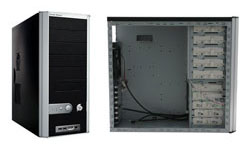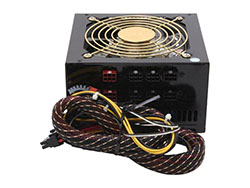Pre-AM2 Mid-Range Buyers' Guide, May 2006
by Jarred Walton on May 9, 2006 6:30 AM EST- Posted in
- Guides
Case and Power Supply
You can choose a case merely for functionality, or your case can make an aesthetic statement. If you don't like our case choice, you're more than welcome to choose something that you do like. The only comment we have is that we like cases that have 120 mm fans, as they tend to be a bit quieter overall. Of course, a high RPM 120mm fan certainly isn't going to be quiet, but you can usually get lower RPM 120mm fans that still move more air than a high RPM 80mm fan.For the power supply, we're going with a separate PSU rather than a case with one included. For the midrange sector, quality takes precedence over price, and bundled power supplies usually are pretty mediocre in terms of quality. They might still be sufficient, especially for a system that's not loaded up with lots of extras, but they will be noisier and less robust. That said, I haven't had a power supply fail in over 18 months, and that includes a couple of junk power supplies that came with $40 cases. If you don't have one, picking up a power meter like the Kill-A-Watt device isn't a bad idea. Even a cheap 400W power supply will often be fine for a long time if your system never draws more than 200W.
 |
| Click to enlarge |
Case Recommendation: Cooler Master Centurion 5 CAC-T05-UW
Price: $61 shipped (Retail)
The Cooler Master Centurion 5 is a decent mid-tower ATX case. You get more external 5.25" bays than you need (5), one external 3.5" bay, and 4 internal 3.5" bays. The case is relatively attractive, and it comes with a tool-less drive mounting mechanism for all the drive bays. It also includes a 120mm rear fan, and you can add an optional 80mm front fan. The case is also available with a side window if you want to spend an extra $10. Finally, the case has front USB, FireWire, headphone, and microphone jacks. It's easy to work with, relatively quiet, and well made.
 |
| Click to enlarge |
PSU Recommendation: Enermax Liberty ELT400AWT ATX12V 400W
Price: $86 shipped (Retail)
I'm a big fan of modular power supplies, ever since OCZ released their first ModStream product. (And incidentally, the 450W ModStream is still going strong after a couple years.) Enermax has now joined the crowd of modular power supply manufacturers with their new Liberty line. As with many of the quality power supplies on the market, you might find the 400W rating seems a little low. Realistically, it's difficult to reach anywhere near 400W without multiple ultra high-end graphics cards, multiple hard drives, and a partridge in a pear tree. Unlike generic brand power supplies, the Enermax Liberty should actually be able to sustain 400W of power output, and it's extremely quiet.
I've got a few other modular power supplies around - OCZ, Kingwin, and Sunbeam - and they all work well for my needs. Not surprisingly, they also cost about the same as the Enermax Liberty, and the higher wattage models cost even more. As the old saying goes, you get what you pay for, and we would recommend sticking with power supplies that cost at least $60, unless you're trying to build a budget system. If you're looking at SLI/CrossFire as a potential upgrade, you might also want to bump the PSU up to a 500W or higher rating.










56 Comments
View All Comments
Griswold - Tuesday, May 9, 2006 - link
Shouldnt always go for the bigger number at a similar price. There are more important numbers with PSUs than the absolute wattage.KorruptioN - Tuesday, May 9, 2006 - link
Even though it's only rated at 400W overall (yes, wattage is not the best indicator of overall output), it can do 30A on the +12V output alone (360W divided by 12V), which is a good amount for a non-SLI configuration. Even two 7600GTs wouldn't be enough to push this power supply past it's limits. I think it is a good all-around choice.JarredWalton - Tuesday, May 9, 2006 - link
I've got a system very similar to this, only with a 7800 GTX, an overclocked X2 3800+, and two 250GB hard drives... all running off a Thermaltake 410W PSU. Maximum power draw hits about 315W - and that's not even counting for PSU efficiency (i.e. that's measuring at the outlet).I mentioned several alternative PSUs that people can consider. Why do I like modular units? Sleeved cables, reduced cable clutter, and for an extra $15 I'm willing to go that route. Opinions vary, naturally - this guide is basically my opinion, after all.
IntelUser2000 - Tuesday, May 9, 2006 - link
Sure about that. Only 35%?? I think 35% will be the absolute minimum over Netburst in Netburst optimized apps.
peternelson - Tuesday, May 9, 2006 - link
Difficult to make comparisons of "same price" netburst cpu, because Intel roadmap will make FURTHER REDUCTIONS in price of 930,940,950 after Core Duo 2 launches through November.950 probably isn't going to compete with the new chips on total performance, but may not be that bad in bang for buck in comparison.
JarredWalton - Tuesday, May 9, 2006 - link
Rough estimate, and it could be more or less depending on benchmarks. Core Duo T2300 costs a bit more than Pentium D 930. Looking at *stock* performance, AutoGK encoding for example should be around 55 FPS for the 930, while the T2400 get 44 FPS. Even with a 25% boost in performance, the Core Duo 2 $210 CPU is probably going to about equal PD 930.The flipped side is that some benches (games especially) will be more than 35%. PD 920 at 2.8 GHz maxes out at 63 FPS in BF2, roughly. (Doesn't matter about resolution - 800x600 still gets ~63 FPS.) Gary got 83 FPS with T2400 at stock, and 112 at 2.8 GHz. If CD2 gives another 25%... we're looking at maybe 104 FPS for a 1.83 GHz Core Duo 2. Assuming such a chip costs $210, it's got a 65% performance advantage. :)
Anyway, I'll tweak the text slightly.